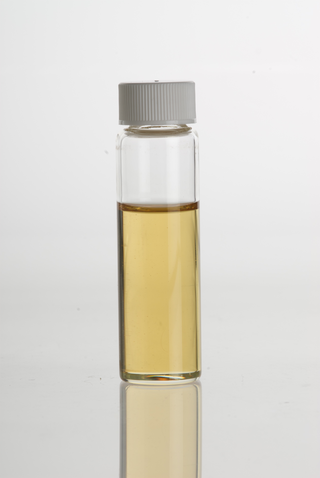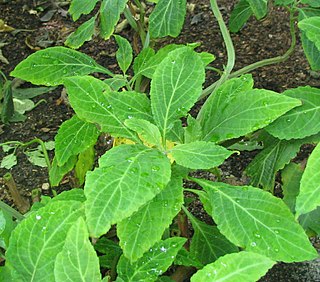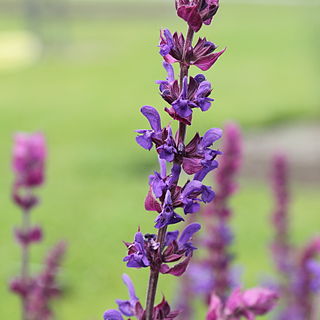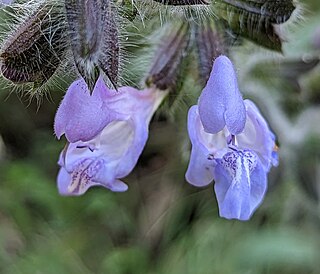
Salvinorin A is the main active psychotropic molecule in Salvia divinorum. Salvinorin A is considered a dissociative hallucinogen.

Salvia officinalis, the common sage or sage, is a perennial, evergreen subshrub, with woody stems, grayish leaves, and blue to purplish flowers. It is a member of the mint family Lamiaceae and native to the Mediterranean region, though it has been naturalized in many places throughout the world. It has a long history of medicinal and culinary use, and in modern times it has been used as an ornamental garden plant. The common name "sage" is also used for closely related species and cultivars.

The Botanical Garden of the University of Vienna is a botanical garden in Vienna, Austria. It covers 8 hectares and is immediately adjacent to the Belvedere gardens. It is a part of the University of Vienna.

Sage oils are essential oils that come in several varieties:

Salvia divinorum, a psychoactive plant, is legal in most countries. Exceptions, countries where there is some form of control, include Australia, Belgium, Brazil, Canada, Denmark, Estonia, Finland, Germany, Iceland, Ireland, Italy, India, Japan, South Korea, Norway, Poland, United Kingdom, Ukraine, Spain, Sweden, Vietnam, Armenia and 33 states and territories of the United States.

Gaillardia aristata is a North American species of flowering plant in the sunflower family, known by the common names common blanketflower and common gaillardia. This perennial wildflower is widespread across much of North America, from Yukon east to Québec and south as far as California, Arizona, Illinois, and Connecticut, although it may be naturalized rather than native in parts of that range. It is also naturalized in scattered locations in Europe, Australia, and South America.

Salvia divinorum is a species of plant in the sage genus Salvia, known for its transient psychoactive properties when its leaves, or extracts made from the leaves, are administered by smoking, chewing, or drinking. The leaves contain the potent compound salvinorin A and can induce a dissociative state and hallucinations.

Salvia indica is a species of herbaceous perennial plant belonging to the family Lamiaceae. It is native to a wide region of Western Asia that includes Israel, Iraq, Iran and Turkey. It was first described by the taxonomist Carl Linnaeus in 1753. It is unknown why he gave it the specific epithet indica, since the plant is not from India. While Salvia indica is classified as a herbaceous perennial, in cultivation individual plants often live no longer than two years.

Salvia is the largest genus of plants in the sage family Lamiaceae, with nearly 1,000 species of shrubs, herbaceous perennials, and annuals. Within the Lamiaceae, Salvia is part of the tribe Mentheae within the subfamily Nepetoideae. One of several genera commonly referred to as sage, it includes two widely used herbs, Salvia officinalis and Salvia rosmarinus.

Salvia nemorosa, the woodland sage, Balkan clary, blue sage or wild sage, is a hardy herbaceous perennial plant native to a wide area of central Europe and Western Asia.

Salvia recognita is a woody-based perennial that is endemic to central Turkey, typically growing in light shade at the base of cliffs, at elevations of less than 4,000 feet (1,200 m). This species has been reported to contain salvinorin A. However, this report has not been replicated, and a previous study of 441 Salvia species from many regions found salvinorin A only in Salvia divinorum, from Mexico.

Salvia macrosiphon is a species of flowering plant in the family Lamiaceae. It is native to Iraq, Iran, Pakistan, Afghanistan, Transcaucasia, and Turkey, where it grows at the edges of fields. It is a perennial herb with a white corolla and ovate nutlets. It flowers in May and fruits from June onwards. Although the plant is similar to S. spinosa, it differs in that it has narrower leaves and calyces, is less indurate and has less spiny fruiting calyces, and possesses a longer corolla tube.

Salvia multicaulis is a low-growing perennial shrub native to Turkey and bordering countries. Plants grow into mats up to 90 cm (3.0 ft) wide, with erect woody stems. The plant reaches 15 cm (5.9 in) tall, though the flowering stems reach 30 to 45 cm. The oval leaves are grey-green, 3 cm (1.2 in) long by 2 cm (0.79 in) wide, with a rugose upper surface and whitish hairy underside.
Salvia marashica is a rare perennial plant that is endemic to Ahır Mountain, near Kahramanmaraş in Turkey. It grows on rocky mountain slopes at 850 to 1,700 m elevation.

Salvia freyniana is a critically endangered perennial plant that is endemic to Turkey, growing in sandy soil at 900 to 1,200 m elevation. It was first collected in 1890, described in 1892 by Joseph Friedrich Nicolaus Bornmüller and not discovered again until 2006. During field trips as part of a revision and study of Salvia species in Turkey, an unusual population of Salvia was discovered which was eventually shown to be the plant described by Bornmueller. It was the first collection of the plant since the original specimens in 1890.
Chamaesphecia doleriformis is a moth of the family Sesiidae. It is found in Italy, Austria, the Czech Republic, Slovakia, the Balkan Peninsula, Ukraine, Russia and Turkey.
Chamaesphecia schmidtiiformis is a moth of the family Sesiidae. It is found in Italy, the Balkan Peninsula and Ukraine. It is also found from Turkey to the Black Sea coast, the Caucasus, Turkmenistan and Iran.

HMS Salvia (K97) was a Flower-class corvette of the Royal Navy. She was ordered on the eve of the Second World War and entered service in September 1940. She rescued many survivors from the prison ship SS Shuntien when it was sunk on 23 December 1941. A few hours later, on Christmas Eve 1941, Salvia too was torpedoed. The corvette sank with all hands, and all of the survivors that she had rescued from Shuntien were also lost.

USCGC Salvia (WLB-400) was a United States Coast Guard Iris-class buoy tender in commission from 1944 to 1991. She operated in the Great Lakes and along the United States Gulf Coast during her career. Sold and renamed Brian Davis in 2020 for use as a memorial vessel, she was scuttled as an artificial reef in 2020.
Salvia hasankeyfensis is a recently identified species of wild sage native to the town of Hasankeyf in southeast Turkey and surrounding areas. The species was discovered during fieldwork in Hasankeyf in 2014 by Tuncay Dirmenci and Özal Güner, and described by them in a 2015 paper written with Ferhat Celep. It appears to be related to Salvia verbenaca, but the authors identify many distinguishing characteristics including S. hasankeyfensis's white petals, and the shapes of the plants' leaves at the base and along the stem. They say it "clearly differs in having denser, narrower, subsessile leaves [that are] always pinnatisect, oblong in outline, a completely different indumentum and white flowers."















